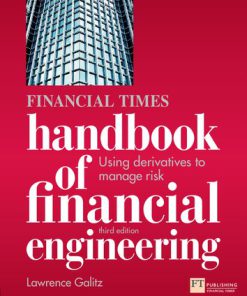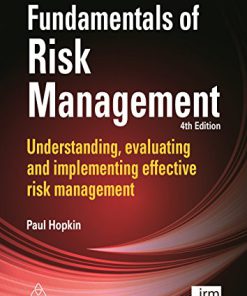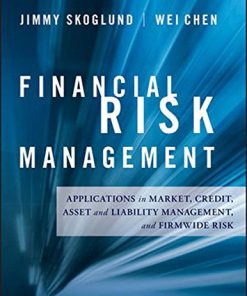Engineering Risk Management 3rd Edition by Thierry Meyer, Genserik Reniers ISBN 3110665425 9783110665420
$50.00 Original price was: $50.00.$25.00Current price is: $25.00.
Engineering Risk Management 3rd Edition by Thierry Meyer, Genserik Reniers – Ebook PDF Instant Download/Delivery: 3110665425, 978-3110665420
Full dowload Engineering Risk Management 3rd Edition after payment

Product details:
ISBN 10: 3110665425
ISBN 13: 978-3110665420
Author: Thierry Meyer, Genserik Reniers
This book is a valuable resource for achieving and promoting a culture of risk awareness and integrating risk management principles and practices into the educational environment.
This integration is essential to ensure that students have the knowledge and skills to identify hazards, and assess and control risks in different contexts through the development and implementation of a risk management curriculum. Besides theoretical considerations and learning to ask the right questions at all times for the sake of critical thinking, effective risk management education also involves the use of case studies, simulations and other experiential learning tools to help students understand and apply risk management concepts in real-life situations. This approach helps students develop a questioning attitude and problem-solving skills, which are essential for effective risk management.
Overall, the interface between risk management and education is essential to develop a generation of professionals who can effectively deal with risks in a variety of contexts. By integrating risk management principles and practices into the educational process, educational institutions can help ensure that their students are well prepared to meet the challenges of the modern world.
Engineering Risk Management 3rd Table of contents:
1. Risk Management Overview
- 1.1 Risk management isn’t just about financial risks.
2. Introduction to Engineering and Managing Risks
- 2.1 Managing risks and uncertainties.
- 2.2 Complexity of risks and uncertainties.
- 2.3 Hazards and risks.
- 2.4 Simplified interpretation of negative risk.
- 2.5 Hazard and risk mapping.
- 2.6 Risk perception and attitude.
- 2.7 Main steps of ERM (Enterprise Risk Management).
- 2.8 Importance and objectives of ERM.
- 2.9 The Black Swan (Type III events).
- 2.10 Role of risk management in education.
- 2.11 Tips for managing risks.
- 2.12 Conclusions.
3. Risk Management Principles
- 3.1 Introduction to risk management.
- 3.2 Integrated risk management.
- 3.3 Risk management models:
- Accident pyramid model.
- P2T model.
- Swiss cheese model and domino theory.
- 3.4 Anatomy of accidents: SIFs (Safety Instrumented Functions) and SILs (Safety Integrity Levels).
- 3.5 Types of risk (individual, societal, and physical).
- 3.6 Safety culture:
- Organizational culture and climate.
- Safety culture models.
- Safety culture models applied (P2T model, Egg Aggregated model).
- 3.7 Strategic management and continuous improvement.
- 3.8 IDEAL S&S model.
- 3.9 Performance indicators.
- 3.10 High-reliability organizations and systemic risks.
- Normal accident theory and high reliability theory.
- HRO principles and risk management.
- 3.11 Accident reporting.
- 3.12 Conclusions.
4. Risk Diagnostic and Analysis
- 4.1 Introduction to risk assessment techniques.
- Inductive vs. deductive methods.
- Risk analysis techniques.
- 4.2 SWOT analysis.
- 4.3 Preliminary hazard analysis.
- 4.4 Checklists.
- Methodology, example, and conclusions.
- 4.5 HAZOP (Hazard and Operability Study).
- Inputs, outputs, process, and examples.
- 4.6 FMECA (Failure Modes, Effects, and Criticality Analysis).
- Inputs, outputs, process, and examples.
- 4.7 Fault tree analysis, event tree analysis, and Cause-Consequence analysis.
- 4.8 Risk matrix.
- 4.9 Quantitative Risk Assessment (QRA).
- 4.10 Layer of Protection Analysis (LOPA).
- 4.11 Bayesian Networks.
- 4.12 Functional Resonance Analysis Method (FRAM).
- 4.13 Tips for using risk diagnostic tools.
- 4.14 Conclusion.
5. Risk Treatment/Reduction
- 5.1 Introduction.
- 5.2 Prevention (e.g., Seveso Directive for chemical plants).
- 5.3 Protection and mitigation.
- 5.4 Risk treatment methodology.
- 5.5 Risk control.
- 5.6 STOP principle.
- 5.7 Resilience.
- 5.8 Tips for implementing risk reduction.
- 5.9 Conclusion.
6. Event Analysis
- 6.1 Traditional analytical techniques:
- Sequence of events, multilinear event sequencing, root cause analysis.
- 6.2 Causal tree analysis.
- Building action plans and implementing solutions.
- 6.3 AcciMap technique.
- 6.4 Organizational learning.
- 6.5 Conclusions.
7. Major Industrial Accidents and Learning from Them
- 7.1 Link between major accidents and legislation.
- 7.2 Examples of major industrial accidents (e.g., Bhopal, Chernobyl, Deepwater Horizon, Fukushima, and others from various years).
- 7.3 Learning from accidents.
- 7.4 Finding problems.
- 7.5 Conclusions.
8. Crisis Management
- 8.1 Introduction.
- 8.2 Steps in crisis management.
- Business continuity plans.
- 8.3 Crisis evolution stages:
- Pre-crisis, acute-crisis, and post-crisis stages.
- 8.4 Proactive vs. reactive crisis management.
- 8.5 Crisis communication.
- 8.6 Tips for implementing crisis management.
- 8.7 Conclusions.
9. Economic Issues of Safety
- 9.1 Accident costs and benefits.
- Examples and calculations.
- 9.2 Prevention costs and benefits.
- 9.3 Safety economics.
- Cost-effectiveness and cost–benefit analysis.
- Risk acceptability and investment analysis.
- 9.4 Safety budget allocation.
- 9.5 Loss aversion and safety as an economic value.
- 9.6 Conclusions.
10. Risk Governance
- 10.1 Introduction.
- 10.2 Risk management systems.
- 10.3 Framework for risk governance.
- 10.4 Risk governance model and layers.
- 10.5 Risk governance PDCA (Plan-Do-Check-Act) cycle.
- 10.6 Risk governance deficits.
- 10.7 Conclusions.
11. Practical Implementation of Risk Management
- 11.1 The MICE concept (Management, Information, Control, and Emergency steps).
- 11.2 Applications in chemistry and physics research.
- 11.3 Emerging technologies (e.g., nanotechnologies).
- 11.4 Tips for implementing risk management in practice.
- 11.5 Conclusions.
12. Concluding Remarks
People also search for Engineering Risk Management 3rd:
systems engineering risk management
software engineering risk management
social engineering risk management strategy document
financial engineering risk management
You may also like…
Business & Economics - Personal Finance
Business & Economics - Management & Leadership
Business & Economics - Personal Finance
Business & Economics - Personal Finance
Business & Economics - Management & Leadership
Engineering - Construction & Building Trades
Data Analytics for Engineering and Construction Project Risk Management Ivan Damnjanovic
Uncategorized
Medicine - Pharmacology
Psychopharmacology: Drugs, the Brain, and Behavior 3rd Edition Jerrold S. Meyer












